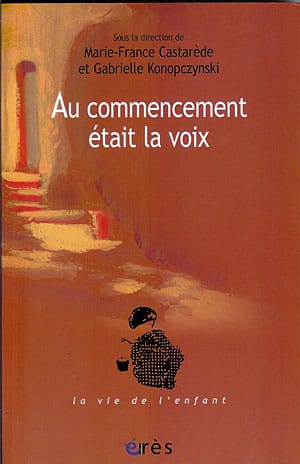The scene is legendary. To sway Minister of the Interior Fouché to the cause of Louis XVIII, stranded at St Ouen, Talleyrand organizes a lavish “supper” at the end of which he serves his guest a very old cognac. The uncouth Duke of Otrante quickly seizes the glass and downs it in one gulp. The Bishop of Autun then lectures him: such rare alcohol, he explains to his illustrious guest, should be looked at, smelled, placed down, and “spoken of.” Ite missa est.
Could the voice be a substitute for oral enjoyment? Since ancient times, mothers have known, according to Marie France Castarède and Gabrielle Konopczynski, that “in the beginning was the voice.” Fetuses recognize from the fourth month the mother’s prosody, meaning the rhythm, melody, and intensity of words that reach them from both outside and inside the mother’s body. However, it will take about ten months for the baby to utter its first words. In this sense, language seems to appropriate—enclose?—sounds that were more freely exchanged from the very beginning of life. The birth cry, in this regard, would mix sound and voice, commemorating the transition from one state to another, a great “leap” of sorts. The acquisition of language could thus mark the end of the breastfeeding period and the start of the process of separation from the mother. A double frustration whose nature and intensity would justify the efforts made by the newborn to now express itself through speech.
According to the poet, the ear has no eyelids. Unlike sight, perhaps closer to the sense of smell, the voice, the authors confirm, reaches the other “without passage through language and representation.” It is as much identity and identification as it is emotion and meaning. It is not surprising that the chapters of the book oscillate between the realm of intersubjectivity and that of art, as if to remind us of the regular swings between structural benchmarks occurring during a psychoanalysis.
Theater, poetry, singing, and opera, as well as teaching professions, are themes addressed by the authors as so many possible correspondences to the infinite textures of a voice. From “momese,” the dialect all mothers of the world use when they talk to their babies with a higher pitch and exaggerated intonation (in “In My Crib There Are Cactuses,” also published by Éditions Eres), to the passion of an audience for the vocal range of a lyrical artist, and through to the symptom of aphonia from which 75% of teachers suffer, the voice can play “different strings” to its bow: it can move or socialize, it can also hurt or destroy. A strange paradox of the human being: sometimes triumphant over the unleashing of elements and overcoming natural disasters, yet it surrenders and collapses in the absence of a loved one’s voice.
Thus, voice and enjoyment converge. And since this column addresses, among others, readers from Nice, let us greet the opening of a “lyrical restaurant,” the “Voci” (48, Bd Victor Hugo), which seeks to merge the two: during a fine meal, young and talented professionals perform opera and bel canto arias. No doubt the oral impulse will find its fulfillment here: voices charm, palates savor, and tongues… comment.
Marie France Castarède, Gabrielle Konopczynski, “In the Beginning Was the Voice,” Éditions Eres, Coll. “The Life of the Child,” 247 p., 23 Euros.
Jean-Luc Vannier
Psychoanalyst
jlvannier@free.fr 06 16 52 55 20


